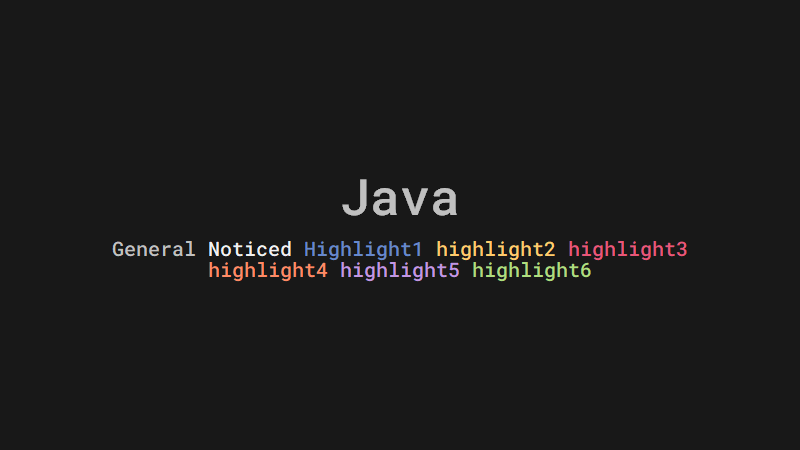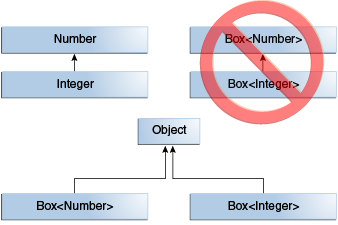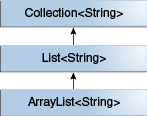
Bound Type Parameters link
There may be times when you want to restrict the types that can be used as type arguments in a parameterized type. For example, a method that operates on numbers might only want to accept instances of Number or its subclasses. This is what bounded type parameters are for.
To declare a bounded type parameter, list the type parameter's name, followed by the extends keyword, followed by its upper bound, which in this example is Number. Note that, in this context, extends is used in a general sense to mean either "extends" (as in classes) or "implements" (as in interfaces).
public class Box<T> {
private T t;
public void set(T t) {
this.t = t;
}
public T get() {
return t;
}
public <U extends Number> void inspect(U u){
System.out.println("T: " + t.getClass().getName());
System.out.println("U: " + u.getClass().getName());
}
public static void main(String[] args) {
Box<Integer> integerBox = new Box<Integer>();
integerBox.set(new Integer(10));
integerBox.inspect("10"); // error: this is still String!
}
}By modifying our generic method to include this bounded type parameter, compilation will now fail, since our invocation of inspect still includes a String:
Box.java:21: <U>inspect(U) in Box<java.lang.Integer> cannot
be applied to (java.lang.String)
integerBox.inspect("10");
^
1 errorResult :
public class Box<T> { ... public <U extends Number> void inspect(U u){ System.out.println("T: " + t.getClass().getName()); System.out.println("U: " + u.getClass().getName()); } public static void main(String[] args) { ... Box<Integer> integerBox = new Box<>(); integerBox.set(10); integerBox.inspect(0.1); // T: java.lang.Integer // U: java.lang.Double ... }
In addition to limiting the types you can use to instantiate a generic type, bounded type parameters allow you to invoke methods defined in the bounds:
public class NaturalNumber<T extends Integer> {
private T n;
public NaturalNumber(T n) { this.n = n; }
public boolean isEven() {
return n.intValue() % 2 == 0;
}
// ...
}The isEven method invokes the intValue method defined in the Integer class through n.
Multiple Bounds
The preceding example illustrates the use of a type parameter with a single bound, but a type parameter can have multiple bounds :
<T extends B1 & B2 & B3>A type variable with multiple bounds is a subtype of all the types listed in the bound. If one of the bounds is a class, it must be specified first. For example:
Class A { /* ... */ }
interface B { /* ... */ }
interface C { /* ... */ }
class D <T extends A & B & C> { /* ... */ }If bound A is not specified first, you get a compile-time error:
class D <T extends B & A & C> { /* ... */ } // compile-time errorGeneric Methods and Bounded Type Parameters link
Bounded type parameters are key to the implementation of generic algorithms. Consider the following method that counts the number of elements in an array T[] that are greater than a specified element elem.
public static <T> int countGreaterThan(T[] anArray, T elem) {
int count = 0;
for (T e : anArray)
if (e > elem) // compiler error
++count;
return count;
}The implementation of the method is straightforward, but it does not compile because the greater than operator (>) applies only to primitive types such as short, int, double, long, float, byte, and char. You cannot use the > operator to compare objects. To fix the problem, use a type parameter bounded by the Comparable<T> interface:
public interface Comparable<T> {
public int compareTo(T o);
}The resulting code will be:
public static <T extends Comparable<T>> int countGreaterThan(T[] anArray, T elem) {
int count = 0;
for (T e : anArray)
if (e.compareTo(elem) > 0)
++count;
return count;
}Generics, Inheritance, and Subtypes link
You can perform a generic type invocation, passing Number as its type argument, and any subsequent invocation of add will be allowed if the argument is compatible with Number:
Box<Number> box = new Box<Number>();
box.add(new Integer(10)); // OK
box.add(new Double(10.1)); // OKNow consider the following method:
public void boxTest(Box<Number> n) { /* ... */ }What type of argument does it accept? By looking at its signature, you can see that it accepts a single argument whose type is Box<Number>. But what does that mean? Are you allowed to pass in Box<Integer> or Box<Double>, as you might expect? The answer is "no", because Box<Integer> and Box<Double> are not subtypes of Box<Number>.
This is a common misunderstanding when it comes to programming with generics, but it is an important concept to learn.
Note: Given two concrete types A and B (for example, Number and Integer), MyClass<A> has no relationship to MyClass<B>, regardless of whether or not A and B are related. The common parent of MyClass<A> and MyClass<B> is Object.
For information on how to create a subtype-like relationship between two generic classes when the type parameters are related, see Wildcards and Subtyping.
Generic Classes and Subtyping
You can subtype a generic class or interface by extending or implementing it. The relationship between the type parameters of one class or interface and the type parameters of another are determined by the extends and implements clauses.
Using the Collections classes as an example, ArrayList<E> implements List<E>, and List<E> extends Collection<E>. So ArrayList<String> is a subtype of List<String>, which is a subtype of Collection<String>. So long as you do not vary the type argument, the subtyping relationship is preserved between the types.

Now imagine we want to define our own list interface, PayloadList, that associates an optional value of generic type P with each element. Its declaration might look like:
interface PayloadList<E,P> extends List<E> {
void setPayload(int index, P val);
...
}The following parameterizations of PayloadList are subtypes of List<String>:
-
PayloadList<String, String>
-
PayloadList<String, Integer>
-
PayloadList<String, Exception>
A sample PayloadList hierarchy

